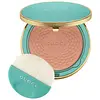What's inside
What's inside
 Key Ingredients
Key Ingredients

 Benefits
Benefits

 Concerns
Concerns

 Ingredients Side-by-side
Ingredients Side-by-side

Caprylic/Capric Triglyceride
MaskingKaolin
AbrasiveCaprylyl Caprylate/Caprate
EmollientSimmondsia Chinensis Seed Oil
EmollientPolyethylene
AbrasiveMica
Cosmetic ColorantPolyhydroxystearic Acid
EmulsifyingLecithin
EmollientBehenylcarbamoylpropyl Polysilsesquioxane
Tocopherol
AntioxidantAscorbyl Palmitate
AntioxidantCitric Acid
BufferingRubus Idaeus Leaf Cell Culture
Skin ConditioningTitanium Dioxide
Cosmetic ColorantCI 77891
Cosmetic ColorantIron Oxides
CI 77491
Cosmetic ColorantCI 77492
Cosmetic ColorantCI 77499
Cosmetic ColorantCI 73360
Cosmetic ColorantBlue 1 Lake
Cosmetic ColorantCI 42090
Cosmetic ColorantCI 15850
Cosmetic ColorantCI 19140
Cosmetic ColorantCaprylic/Capric Triglyceride, Kaolin, Caprylyl Caprylate/Caprate, Simmondsia Chinensis Seed Oil, Polyethylene, Mica, Polyhydroxystearic Acid, Lecithin, Behenylcarbamoylpropyl Polysilsesquioxane, Tocopherol, Ascorbyl Palmitate, Citric Acid, Rubus Idaeus Leaf Cell Culture, Titanium Dioxide, CI 77891, Iron Oxides, CI 77491, CI 77492, CI 77499, CI 73360, Blue 1 Lake, CI 42090, CI 15850, CI 19140
Synthetic Fluorphlogopite
C30-45 Alkyl Dimethicone
Skin ConditioningSilica
AbrasiveButyrospermum Parkii Butter
Skin ConditioningSorbitan Isostearate
EmulsifyingC20-24 Alkyl Dimethicone
Skin ConditioningCaprylyl Glycol
EmollientEthylhexylglycerin
Skin ConditioningParfum
MaskingPolymethylsilsesquioxane
C20-24 Olefin
Skin ConditioningDiethylhexyl Syringylidenemalonate
Skin ProtectingRicinus Communis Seed Oil
MaskingSodium Hyaluronate
HumectantAlumina
AbrasiveLimonene
PerfumingCaprylic/Capric Triglyceride
MaskingHydrogenated Castor Oil
EmollientLinalool
PerfumingGlycerin
HumectantZinc Stearate
Cosmetic ColorantBenzyl Salicylate
PerfumingCitronellol
PerfumingGeraniol
PerfumingCitral
PerfumingMica
Cosmetic ColorantCitric Acid
BufferingTin Oxide
AbrasiveIron Oxides
CI 77891
Cosmetic ColorantSynthetic Fluorphlogopite, C30-45 Alkyl Dimethicone, Silica, Butyrospermum Parkii Butter, Sorbitan Isostearate, C20-24 Alkyl Dimethicone, Caprylyl Glycol, Ethylhexylglycerin, Parfum, Polymethylsilsesquioxane, C20-24 Olefin, Diethylhexyl Syringylidenemalonate, Ricinus Communis Seed Oil, Sodium Hyaluronate, Alumina, Limonene, Caprylic/Capric Triglyceride, Hydrogenated Castor Oil, Linalool, Glycerin, Zinc Stearate, Benzyl Salicylate, Citronellol, Geraniol, Citral, Mica, Citric Acid, Tin Oxide, Iron Oxides, CI 77891
 Reviews
Reviews

Ingredients Explained
These ingredients are found in both products.
Ingredients higher up in an ingredient list are typically present in a larger amount.
This ingredient is an emollient, solvent, and texture enhancer. It is considered a skin-softener by helping the skin prevent moisture loss.
It helps thicken a product's formula and makes it easier to spread by dissolving clumping compounds.
Caprylic Triglyceride is made by combining glycerin with coconut oil, forming a clear liquid.
While there is an assumption Caprylic Triglyceride can clog pores due to it being derived from coconut oil, there is no research supporting this.
Learn more about Caprylic/Capric TriglycerideCi 77891 is a white pigment from Titanium dioxide. It is naturally found in minerals such as rutile and ilmenite.
It's main function is to add a white color to cosmetics. It can also be mixed with other colors to create different shades.
Ci 77891 is commonly found in sunscreens due to its ability to block UV rays.
Learn more about CI 77891Citric Acid is an alpha hydroxy acid (AHA) naturally found in citrus fruits like oranges, lemons, and limes.
Like other AHAs, citric acid can exfoliate skin by breaking down the bonds that hold dead skin cells together. This helps reveal smoother and brighter skin underneath.
However, this exfoliating effect only happens at high concentrations (20%) which can be hard to find in cosmetic products.
Due to this, citric acid is usually included in small amounts as a pH adjuster. This helps keep products slightly more acidic and compatible with skin's natural pH.
In skincare formulas, citric acid can:
While it can provide some skin benefits, research shows lactic acid and glycolic acid are generally more effective and less irritating exfoliants.
Most citric acid used in skincare today is made by fermenting sugars (usually from molasses). This synthetic version is identical to the natural citrus form but easier to stabilize and use in formulations.
Read more about some other popular AHA's here:
Learn more about Citric AcidMica is a naturally occurring mineral used to add shimmer and color in cosmetics. It can also help improve the texture of a product or give it an opaque, white/silver color.
Serecite is the name for very fine but ragged grains of mica.
This ingredient is often coated with metal oxides like titanium dioxide. Trace amounts of heavy metals may be found in mica, but these metals are not harmful in our personal products.
Mica has been used since prehistoric times throughout the world. Ancient Egyptian, Indian, Greek, Roman, Aztec, and Chinese civilizations have used mica.
Learn more about MicaThis ingredient is a combination of red, black, and yellow iron oxide pigments. This combination of colors is usually found in foundation, because it results in a "skin" color.